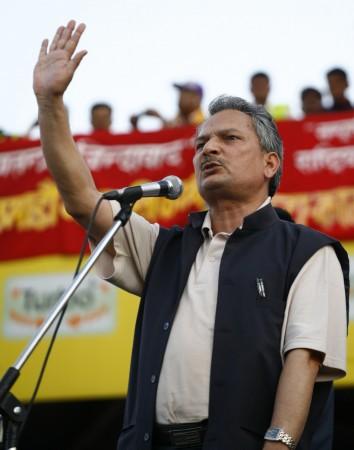
The U.S. State Department has begun the process of removing the Communist Party of Nepal (Maoists) from its Foreign Terrorist Organization list now that it is governing the country.
The process has come after the Himalayan nation formed a Maoist government led by its leader Baburam Bhattarai.
The party's removal from the list was confirmed by State Department spokeswoman Victoria Nuland during a daily press briefing.
"The Communist Party of Nepal (Maoist) is not included on the Foreign Terrorist Organization list," said Nuland.
"But it remains a designated Specially Designated Global Terrorist under Executive Order 13224 and is included on the Terrorism Exclusion List, pursuant to the Immigration and Nationality Act.," she added. "While the party has taken some positive steps, we continue to have areas of concern which must be addressed before the party could be delisted."
Profile of Baburam Bhattarai
DOB- 26 May, 1954
Place of birth - Belbas, Nepal
Political party- United Communist Party Of Nepal
Alma mater and his political career:
The student from Amar Jyoti Janata Secondary School topped the tough School-Leaving Certificate examination in 1970, following it up two years later with the same performance in the intermediate examination as a science student from Kathmandu's Amrit Science Campus.
Bhattarai graduated from the Chandigarh College of Architecture and followed it up with a master's degree from the Delhi School of Planning and Architecture, where he met Hisila Yami, his future wife, as well as Indian author and activist, Arundhati Roy.
In 1986, he completed his PhD from New Delhi's Jawaharlal Nehru University, which, he says, also taught him his first lessons in communism.
His dissertation, 'The Nature of Underdevelopment and Regional Structure of Nepal - A Marxist Analysis', was published later as a book by a Delhi publisher when the Maoists were underground in Nepal, waging an armed war against the state.
In 1996, Bhattarai went underground as the Maoists launched their 'People's War', seeking the abolition of monarchy and a constitution to be written by elected people's representatives.
In the course of the 10-year war, which killed more than 17,000 people, Bhattarai lived in hiding in Indian cities off and on, remaining in touch with Indian Communist leaders.
Around 2004-2005, his relations with the Maoist chief Pushpa Kamal Dahal Prachanda soured, leading to his being suspended from the party along with his wife, Hisila, and being kept virtually under house arrest in a remote village in Nepal.
In 2006, after signing an agreement with Nepal's major parties, the Maoists led public protests in Nepal for 19 days that forced the king to step down.
Two years later, the Maoists emerged as the largest party following a historic election and Bhattarai won the highest number of votes, contesting from Gorkha.
He was finance minister during the short-lived Prachanda government with his policies seeing an unprecedented rise in state revenues.
However, with the fall of the Prachanda government in 2009 and fresh races for the formation of new governments, the tussle with Prachanda resurfaced, causing the Maoist supremo to drag his feet on fielding Bhattarai as the prime ministerial candidate.
The Communist Party of Nepal-Maoist (CPN-M) was formed in 1995, following a split in the Communist Party of Nepal-Unity Centre. A radical faction led by Pushpa Kamal Dahal alias Comrade Prachanda and Baburam Bhattarai set up the CPN-Maoist and opposed the Communist Party of Nepal (Unified Marxist-Leninists).
It resorted to an armed struggle on February 13, 1996, by attacking police stations in the Rukum and Rolpa districts in northwestern Nepal and thereby declaring a 'People's War' in Nepal.
The U.S Department of State's List of Designated Foreign Terrorist Organizations
- 1. Abu Nidal Organization (ANO)
- 2. Abu Sayyaf Group (ASG)
- 3. Al-Aqsa Martyrs Brigade (AAMS)
- 4. Al-Shabaab
- 5. Ansar al-Islam (AAI)
- 6. Asbat al-Ansar
- 7. Aum Shinrikyo (AUM)
- 8. Basque Fatherland and Liberty (ETA)
- 9. Communist Party of the Philippines/New People's Army (CPP/NPA)
- 10. Continuity Irish Republican Army (CIRA)
- 11. Gama'a al-Islamiyya (Islamic Group)
- 12. HAMAS (Islamic Resistance Movement)
- 13. Harakat ul-Jihad-i-Islami/Bangladesh (HUJI-B)
- 14. Harakat ul-Mujahidin (HUM)
- 15. Hizballah (Party of God)
- 16. Islamic JihadUnion (IJU)
- 17. Islamic Movement of Uzbekistan (IMU)
- 18. Jaish-e-Mohammed (JEM) (Army of Mohammed)
- 19. Jemaah Islamiya organization (JI)
- 20. Kahane Chai (Kach)
- 21. Kata'ib Hizballah (KH)
- 22. Kongra-Gel (KGK, formerly Kurdistan Workers' Party, PKK, KADEK)
- 23. Lashkar-e Tayyiba (LT) (Army of the Righteous)
- 24. Lashkar i Jhangvi (LJ)
- 25. Liberation Tigers of Tamil Eelam (LTTE)
- 26. Libyan Islamic Fighting Group (LIFG)
- 27. Moroccan Islamic Combatant Group (GICM)
- 28. Mujahedin-e Khalq Organization (MEK)
- 29. National Liberation Army (ELN)
- 30. Palestine Liberation Front (PLF)
- 31. Palestinian Islamic Jihad (PIJ)
- 32. Popular Front for the Liberation of Palestine (PFLP)
- 33. PFLP-General Command (PFLP-GC)
- 34. al-Qaida in Iraq (AQI)
- 35. al-Qa'ida (AQ)
- 36. al-Qa'ida in the Arabian Peninsula (AQAP)
- 37. al-Qaida in the Islamic Maghreb (formerly GSPC)
- 38. Real IRA (RIRA)
- 39. Revolutionary Armed Forces of Colombia (FARC)
- 40. Revolutionary Organization 17 November (17N)
- 41. Revolutionary People's Liberation Party/Front (DHKP/C)
- 42. Revolutionary Struggle (RS)
- 43. Shining Path (Sendero Luminoso, SL)
- 44. United Self-Defense Forces of Colombia (AUC)
- 45. Harakat-ul Jihad Islami (HUJI)
- 46. Tehrik-e Taliban Pakistan (TTP)
- 47. Jundallah
- 48. Army of Islam (AOI)









